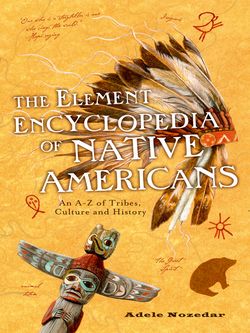Читать книгу The Element Encyclopedia of Native Americans: An A to Z of Tribes, Culture, and History - Adele Nozedar - Страница 8
ABENAKI
ОглавлениеThis group, who were concentrated in what has become New Hampshire and Maine, are a part of the Algonquian people and were among the first of the Native peoples of North America that European settlers would have encountered. The coming of the white man’s diseases, along with the risk of annihilation by warring French and English factions, forced the tribe into Quebec in the later part of the 17th century.
The Abenaki people refer to themselves as Alnobak, which means “The Real People” or “men.” It was not uncommon among Native American nations to refer to themselves in this way. The origin of the word Abenaki is from Wabanaki, which translates as “People of the Dawn Lands,” a reference to their home in the east.
One Abenaki myth states that the god Kechi Niwaskw created the first man and the first woman from stone; however, Kechi Niwaskw wasn’t happy, destroyed his first attempt at sculpture, and instead carved his creation again from wood. The Abenaki believed that they were descended directly from these wooden figures.
There was an Abenaki Confederacy, a unified group that encompassed the Penobscot, the Passamaquoddy, and Malecite peoples.
The traditional home of the Abenaki is the wigwam, a semipermanent structure usually covered in bark or fabric. The word “wigwam” mistakenly became the generic term used by European settlers for any semipermanent Native American dwelling, because they assumed that this was what the word meant.
The Abenaki survived by hunting, fishing, and agriculture. Their crops would have included corn, potatoes, and, of course, tobacco. At the time that explorers and settlers first encountered them, the Abenaki lived in small groups or villages, each enclosed by wooden fences. They knew that the flesh and bones of fish made an efficient fertilizer, and so had the habit of burying a couple of dead fish at the base of each stem of maize. Using fish as fertilizer was an area of expertise which would be adopted by the settlers in later years—and, indeed, is still in common practice today.
The Abenaki also knew how to make a delicious sweet syrup from the sap of the maple tree—maple syrup—something that wild food-lovers even today celebrate as a great delicacy. The Abenaki were, and are, skilled at basketware.
The area belonging to the Abenaki was situated between Massachusetts and Quebec, areas that came to be colonized by the English and the French respectively, who subsequently went to war with one another.
The Abenaki gravitated toward the French side during the Anglo-French Wars, and one of their warriors—Nescambuit—was made a knight after he slayed over 140 enemies of the French king, Louis XIV. The allegiance of the Abenaki toward the French could have come about because of their relationship with an early French missionary, a Jesuit priest named Father Sebastian Rasles, whose mission was at Norridgewock on the Kennebec River. In 1722 the British destroyed the mission and killed Father Rasles; among his papers was discovered an Abenaki-French dictionary that he had been working on. Also, in 1614, 24 young Abenaki had been kidnapped by the British and shipped back to England, an outrage that would also have been a key factor in helping the Abenaki to decide which side they should support.
Contemporary accounts from the Jesuits who had dealings with the Abenaki described them as “not cannibals,” and also as “not profane.”
In contrast to other peoples such as the Iroquois, the Abenaki followed the patrilineal line (in which the nation of the father was considered to be the nation of the child) as opposed to the matrilineal. This arrangement was common to the New England peoples but unusual among Native Americans on the whole.
Single Abenaki men could be identified by their long, untied hair; when a prospective wife came along, the man would tie back his hair. Once married, the Abenaki husband showed his status by sporting only a high ponytail and shaving the rest of his head. Before the need to alter his hairstyle arrived, however, there was the matter of arranging the marriage. This wasn’t always simple. A proposal of marriage was not simply for the prospective partners, but a matter for the whole village. And the bride and groom would make a gift to one another of a fine box, engraved with the loved one’s attributes.
Other decisions besides betrothals were decided by the entire group. Everyone was given the right to an equal say, and to simplify matters various members would elect a single spokesperson. The Abenaki also had a system in which an impartial person would arbitrate in the case of disagreements. Until all parties agreed, there was no resolution.
At the time of writing, the Abenaki are still not recognized federally, although the state of Vermont recognized their status as a People in 2006. At the time, the authorities noted that many of the Abenaki had been “assimilated.”
